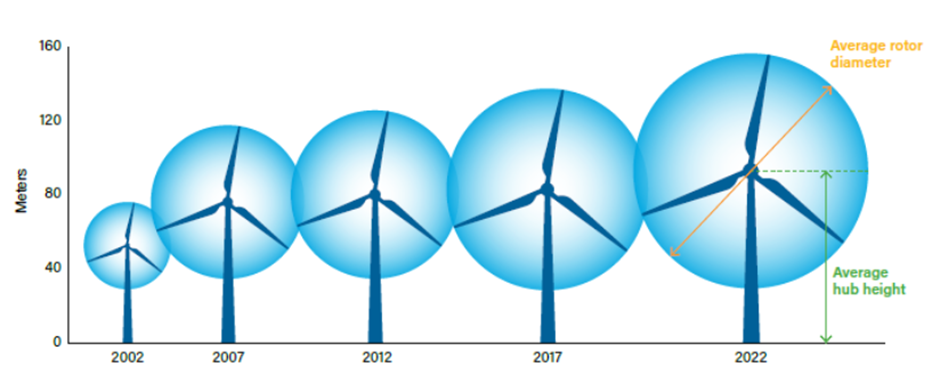The Power of Scale: Solutions for Next-Gen Wind Turbines
Written by Brett Horvath, PE, Project Manager; Evan Zik, PE, Senior Project Manager
The wind energy sector is witnessing a significant transformation, with land-based turbines getting larger and more powerful. This evolution is not just about the turbines themselves but also the logistics and infrastructure required to accommodate these giants. As the blades lengthen and tower sections grow, the challenges in transportation and installation require a more sophisticated approach. This blog will explore specialized solutions that support the delivery and installation of growing land-based wind turbines.
Managing the Growth
According to American Clean Power, over the past decade, the average hub height of land-based wind turbines has increased by 16% since 2012, reaching 94 meters in 2022, while the average rotor diameter has reached 127 meters, a 40% increase from 2012. Today, the average turbine capacity is 3.1 MW, compared to an average of 2.9 MW in 2021.

American Clean Power, 2022, Annual Market Report
The growth in turbine size has led to more complex projects with challenging transportation requirements. To manage these challenges effectively, a multidisciplinary approach is essential. Teams specializing in site design, and traffic coordination must work in unison to ensure the roads and sites are ready for the equipment. This collaboration is crucial from early-stage development through construction to provide cost-effective solutions while minimizing impacts to the public and the environment.
Our innovative service teams have developed several tools to help streamline turbine deliveries that can be especially helpful when managing larger turbines.
Delivery Route Analysis
A critical task is conducting a Delivery Route Analysis (DRA). These are typically completed during the feasibility stage or at early milestones of the civil plans. DRAs document potential issues or obstructions along the anticipated haul routes, excluding access roads not yet built. This data is then shared with the client and the site design team to improve plans and mitigate future delivery issues.
Road Use Agreement
Road Use Agreements (RUAs) are legal permitting documents between the developer and the jurisdiction, which are essential for outlining the responsibilities and expectations for road use during equipment transportation and installation. Although these agreements can vary widely, it's crucial to accurately document the existing conditions of roads and structures to ensure repairs leave them in “as good or better condition than before.” In the end, the RUA helps reduce impacts to the local community and risk exposure for the developer. At Westwood, we can help document pre- and post-construction conditions, design existing road upgrades, and expedite the RUA negotiation process.
Trial Runs
Trial runs are conducted during the construction phase, a few weeks before the actual deliveries begin. They investigate the as-built conditions on-site to limit demurrage, which is the costly delay in unloading or offloading equipment. Our team plays a pivotal role in documenting the as-built conditions and identifying any last-minute obstructions that could impede turbine delivery and cost the project money. A color-coded risk report and web-based data reporting will help your team quickly identify and resolve essential list items before deliveries arrive at the site. Trial runs are more expensive than DRAs due to their timing and the need for precision in the construction phase. It’s important to schedule trial runs appropriately to minimize multiple
Demurrage Tracking
Most Turbine Supply Agreements (TSA) include demurrage penalties for costly delays in unloading or offloading equipment. The TSA typically defines which delays incur demurrage fees. It’s important to know what caused the delay and its duration in determining demurrage.
Demurrage tracking is a critical service that can save clients significant money. By tracking deliveries and denoting true cases for demurrage, clients can better manage delay fees and avoid unnecessary costs that can sometimes exceed $1 million. This proactive approach helps reduce last-second conflicts and unwarranted stress for clients and staff. Field teams can use our web-based Demurrage Accounting Platform (DAP) to record delivery time, offload time, and cause of any delays. Automated demurrage calculations, a time-sensitive dashboard, and e-mail status reporting will keep your team current on the real-time impacts of delays to your project costs.
Ready for the Future
The wind energy sector is scaling up, with turbines becoming more prominent and the logistics more intricate. The continued growth of these machines hinges on the ability to manage the complexities through effective project management, specialized assessments, and a keen eye on the details that can make or break timely installation. Reach out to us if your team needs to explore specialized solutions for your growing land-based wind turbines.